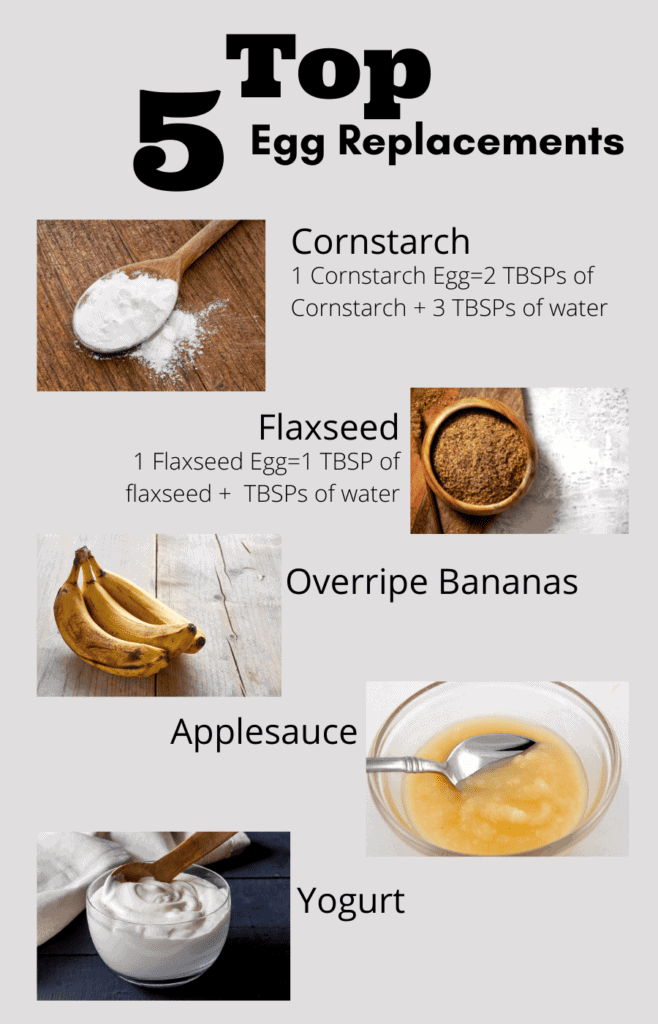Baking without eggs seems a little daunting at first but it is 100% doable! I hope these egg replacement tips are helpful.

Top 5 Egg Replacements
1. Cornstarch
Cornstarch is a wonderful egg replacer for baking. It works well in custards, pies, and puddings. The key to replacing an egg with cornstarch is the cornstarch to water ratio.
1 Cornstarch Egg = 2 TBSPs of Cornstarch + 3 TBSPs of water
2. Flaxseed
Flaxseed eggs work wonderfully when baking cakes and brownies. It is not only nutritious, but also creates that familiar texture you expect in a cake. Other replacements can make your cake too moist which alters the texture and structure of your cake.
1 Flaxseed Egg = 1 TBSP of Flaxseed + 3 TBSPs of Water
Allow your flaxseed egg to thicken in the fridge for 15 minutes for best results.
3. An Overripe Banana
Banana are great egg replacers for breads, muffins, pancakes, and even cookies. The moisture of the banana helps the ingredients bind together and it adds to the sweet flavor of your baked good. You may even be able to reduce the sugar in your recipe with this egg replacement.
4. Applesauce
Applesauce is another option to replace your eggs with muffins and quick breads. The pectin in the applesauce acts as a binder just as eggs would in your recipe. However, when using applesauce, you have to be cautious because it adds a fair bit of moisture to your recipe which can make your end result much more dense. To keep a lighter texture, consider adding an extra half teaspoon of baking powder to your recipe.
5. Yogurt
Yogurt is another great substitute for baking without eggs in muffins, cakes, cupcakes, and quick breads. The protein and fat levels of the yogurt help bind the batter together, add some sweetness, and make a nice moist bread. You can use regular or greek yogurt. You may even be able to use non-dairy yogurt if needed.
Tips for Baking with Cornstarch
When you make your cornstarch egg, make sure you are adding the cornstarch to cold water in its own dish. If you add cornstarch and water straight into your batter, you will end up with clumps of cornstarch. By making the cornstarch with cold water in its own dish first, the cornstarch fully incorporates with the water and then is easily mixed in with your batter.

Cornstarch is actually an anti-caking agent, which means it draws in the moisture. As a result, it will create a light and chewy texture in baked goods. If you are wanting to create a tender texture, cornstarch may work well in your recipe. Cookies, brownies, and shortbreads are great times to use cornstarch for its texture benefits.
Cornstarch is an excellent thickener when baking or cooking. Commonly used for thickening sauces, gravies, and soups when cooking, cornstarch also thickens puddings and pie fillings when baking. Finally, a solution to having a runny pie when you cut into it, use cornstarch when baking! (Also make sure to let your pie cool before slicing.)
Tips for Baking with Flaxseed
Flaxseed eggs are wonderful at binding your ingredients together, and the best at creating a fluffy texture. If your recipe is using eggs to create a fluffy cake, you may want to consider using a combination of egg replacements. For instance, combine flaxseed egg and yogurt for a light and moist baked good.

Remember to create your flaxseed egg when you start baking. It needs to sit in the fridge for 15 minutes in order to gel up and produce the best results.
Tips for Baking with Bananas
Use overripe bananas. The peel can be speckled or even turning black. This is when the banana flavor is most abundant and it is rich in antioxidants. While the texture of an overripe banana isn’t all that appealing to eat by itself, it is wonderful when baking.

If your bananas aren’t ripe, put them in a brown paper bag in a warm, dry spot and check them the next day. The ethylene gas given off by the ripening bananas circulates in the bag and causes them to ripen faster.
Tips for Baking with Applesauce
Applesauce adds a lot of moisture when baking. Which can be a great thing. However, keep that in mind if your recipe calls for a lot of oil. For example, pumpkin bread has a cup of oil. If you simply substitute the egg for applesauce and don’t reduce the oil or add extra baking powder, your bread will be very moist and dense. It will still taste great, but the texture will be different than your typical pumpkin bread.

Use unsweetened applesauce to prevent your baked goods from being too sweet.
If you have homemade applesauce, it is likely to be thicker than store-bought applesauce. As a result, you may have to change your ratios slightly when adding it as a replacer or add a little water to it to create your desired result.
Tips for Baking with Yogurt
Use plain Greek yogurt to achieve the best results. The thickness and creaminess of the yogurt helps your baked goods stay moist.
If you want a light and fluffy cake, use yogurt because the acidity of the yogurt helps activate the baking soda. When baking soda is activated, it releases carbon dioxide which caused the baked good to rise.

Make your own yogurt to maximize the health benefits. If you have an instant pot with the yogurt setting you can follow Steiger Family Farm’s Easy, Instant Pot, Gut Healthy Yogurt Recipe.
A Note About Ingredients
I always suggest finding organic non-GMO ingredients to maximize your health benefits and minimize inflammation within your body. Chances are, you will be using these ingredients often. Whether you are baking or cooking, high-quality ingredients are worth investing in for your overall health.







Your idea is useful